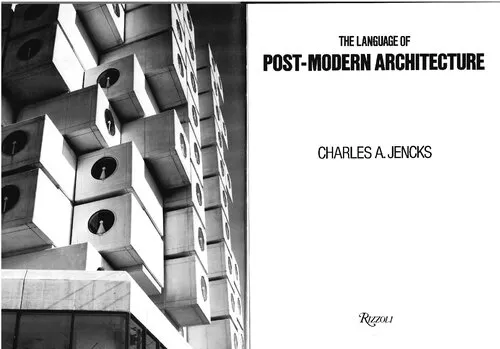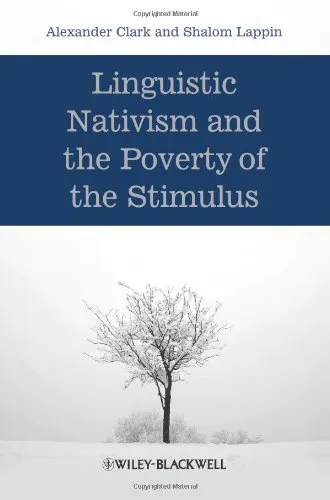The language of post-modern architecture
4.5
بر اساس نظر کاربران

شما میتونید سوالاتتون در باره کتاب رو از هوش مصنوعیش بعد از ورود بپرسید
هر دانلود یا پرسش از هوش مصنوعی 2 امتیاز لازم دارد، برای بدست آوردن امتیاز رایگان، به صفحه ی راهنمای امتیازات سر بزنید و یک سری کار ارزشمند انجام بدینکتاب های مرتبط:
معرفی کتاب "The Language of Post-Modern Architecture"
کتاب "The Language of Post-Modern Architecture" نوشته چارلز جنکس یکی از آثار بنیادین در زمینه معماری پستمدرن است که به تحلیل و نقد معماری سنتی و مدرن پرداخته و مفاهیمی نوین برای فهم معماری پستمدرن ارائه میدهد. این کتاب که برای اولین بار در سال 1977 منتشر شد، نقطه عطفی در درک تغییرات فرهنگی و هنری قرن بیستم به شمار میآید.
جنکس در این کتاب، زبان و قواعد معماری پستمدرن را معرفی کرده و آن را به عنوان واکنشی به معماری مدرن و جنبشهای پیشین تفسیر میکند. این کتاب تأکید دارد که معماری پستمدرن تنها یک سبک نیست، بلکه مجموعهای از اصول، سمبلها و سیستمهای معنایی است که به بافت فرهنگی و اجتماعی وابسته هستند.
خلاصهای مفصل از کتاب
کتاب "The Language of Post-Modern Architecture" در چندین فصل به بررسی معماری پستمدرن میپردازد. جنکس در ابتدا زمینه تاریخی پستمدرنیسم را مطرح میکند و نقدی تند به محدودیتهای معماری مدرن وارد میکند. به باور او، معماری مدرن با تأکید بیش از حد بر ماهیت عملکردی و سادهنگری، از درک معنای عمیقتر محیط انسانی غافل شده است.
او سپس به بررسی اصول پستمدرنیسم میپردازد، مانند ترکیب سنت و نوآوری، استفاده از استعارههای فرهنگی، و بازگشت به ارزشهای تاریخی. جنکس در بخشهای مختلف کتاب به معرفی معماران برجستهای مانند رابرت ونتوری، آلدروسی و مایکل گریوز پرداخته و آثار آنان را مورد تحلیل قرار میدهد.
علاوه بر آن، جنکس مفهوم "Double Coding" را توضیح میدهد، یعنی توانایی معماری پستمدرن در ارتباط با دو گروه مختلف مخاطبان: نخبگان متخصص و عموم مردم. این مفاهیم بهصورت تصویری و همراه با نقشهها و عکسهای معماری توضیح داده میشود که به فهم بهتر ایدهها کمک شایانی میکند.
نکات کلیدی کتاب
- معرفی اصول معماری پستمدرن و تحلیل تفاوتهای آن با معماری مدرن.
- توضیح مفهوم "Double Coding" و اهمیت آن در ارتباط با مخاطبان.
- بررسی تطبیقی آثار برجسته معماران پستمدرن و نوگرایان.
- نقش نمادها، استعارهها و ارزشهای تاریخی در آثار معماری.
- نقد جنکس بر یکنواختی و خالی بودن معنایی معماری مدرن.
جملات مشهور از کتاب
“Every building is a message; the question is not whether it communicates but what it communicates.”
“Modern Architecture died in St. Louis, Missouri on July 15, 1972, at 3:32 p.m. when the infamous Pruitt-Igoe scheme, or rather several of its slab blocks, were given the final coup de grâce by dynamite.”
چرا این کتاب مهم است؟
"The Language of Post-Modern Architecture" از جنبههای گوناگون اثری مهم در دنیای معماری تلقی میشود. این کتاب توانست گفتمانی نوین در معماری ایجاد کند و معماران را تشویق کرد تا دیدگاههای غیرخطی درباره طرحها و فرمها داشته باشند. از طرفی، این اثر تنها به متخصصان محدود نمیشود و برای عامه مردم نیز با جذابیت فراوان همراه است، چرا که جنکس با استفاده از عکسها و نقشههای متعدد این مفاهیم پیچیده را به صورتی ساده و قابل درک ارائه میدهد.
علاوه بر آن، این کتاب نشاندهنده تغییرات بزرگ فرهنگی و اجتماعی قرن بیستم است که از طریق معماری بازتاب داده شدهاند. نقشی که این کتاب در شکلگیری آموزش معماری و همچنین درک عمومی از هنر و فرهنگ ایفا کرده بیبدیل است و همچنان تأثیرگذاری خود را حفظ کرده است.
Introduction to "The Language of Post-Modern Architecture"
"The Language of Post-Modern Architecture" by Charles Jencks is a landmark book that transformed how architects, critics, and the public understand architectural history and modern design practices. First published in 1977, this influential work stands as a cornerstone in architectural literature, introducing readers to the concept of Post-Modern architecture as a distinct and revolutionary movement that reacts to modernism's rigidity and universality. Jencks unpacks complex ideas about architectural semiotics, symbolism, and historical context, which have fundamentally shaped contemporary thought on the built environment.
With its provocative tone, rich theoretical analysis, and sharp critiques of modernist dogma, the book rapidly became a manifesto for architects seeking new ways to integrate culture, plurality, and symbolism into their designs. It is renowned for popularizing the exact moment modernism 'died'—a key moment in the architectural history timeline. As a text, it bridges the gap between architecture as a functional discipline and its role as a cultural expression, making it an essential read for anyone interested in understanding post-modernity in the architectural world.
Detailed Summary of the Book
Jencks provides a comprehensive narrative on the evolution of architecture from modernism to post-modernism, exploring how the latter emerged as a reactionary movement to the uniformity and perceived failures of modernist ideology. He critiques modernism for its neglect of context, historical references, and the varied experiences of local communities. In its place, he advocates for an architecture that is pluralistic, contextually sensitive, and rich in symbolism.
The book divides its discussion into key chapters that explore aspects such as the symbols and languages embedded in architecture, the rise of eclecticism in the Post-Modern era, and the embrace of populism and cultural diversity in design. Through examples of iconic works by architects like Robert Venturi, Michael Graves, and Frank Gehry, Jencks illustrates how Post-Modern architecture melds the global and the local, often with playful creativity and irony. On the other end, he analyzes the philosophical and sociopolitical underpinnings of the movement, presenting architecture as a language replete with signs, metaphors, and layered meanings.
Perhaps the most famous aspect of the book is Jencks’s claim that modernist architecture died on July 15, 1972, at precisely 3:32 PM, with the demolition of the Pruitt-Igoe housing project. This dramatic declaration underscores his view that modernism had failed to address the human and cultural needs of society, and thus a new architectural paradigm was born. Beyond a critique, the book serves as an optimistic call for a richer architectural expression that embraces history, diversity, and human emotion.
Key Takeaways
- Post-Modern architecture emerged as a reaction to the limitations of modernism, emphasizing diversity, symbolism, and contextual relevance.
- The book introduces architecture as a form of communication, filled with signs, metaphors, and "languages" that speak to different cultural contexts.
- Charles Jencks demonstrates the necessity of reconciling global aspirations with local identities in architectural design.
- The demolition of the Pruitt-Igoe housing complex in 1972 became a symbolic moment marking the 'death' of modernism and the birth of a new architectural age.
- The work challenges architects to embrace plurality, creativity, and humanity in their designs, generating spaces that speak to multiple interpretations and meanings.
Famous Quotes from the Book
"Modern architecture died in St Louis, Missouri on July 15, 1972, at 3:32 PM (or thereabouts) when the infamous Pruitt-Igoe scheme, or rather several of its slab blocks, were given the final coup de grâce by dynamite."
"Post-Modern architecture is fundamentally a pluralist style that draws upon multiple languages and traditions, in service of creating spaces that are meaningful to society."
"Architecture must touch upon the sacred, the human, and the meaningful if it is to retain its relevance in a rapidly transforming world."
Why This Book Matters
"The Language of Post-Modern Architecture" matters because it presents a groundbreaking reinterpretation of architecture's purpose in society. Jencks challenges the detached formalism and rigidity of modernist thought, replacing it with a vision of architecture that is rich in cultural symbolism and historical references. His work helped to usher in a new era, inspiring architects and thinkers to consider the social, political, and artistic implications of their works.
Beyond its academic value, the book serves as a bridge between architecture and other fields such as semiotics, philosophy, and cultural studies. It demonstrates that architecture is not merely about building structures but about creating environments that resonate with human experiences and aspirations. By addressing this profound intersection of design and meaning, Jencks's work continues to inspire a fresh dialogue about the role of architecture in a diverse and interconnected world.
For students, professionals, and enthusiasts of architectural theory, this book remains essential reading. Its timeless insights into the post-modern condition and its call for a humane, eclectic, and meaningful architecture ensure its lasting relevance in architectural discourse.
دانلود رایگان مستقیم
You Can Download this book after Login
دسترسی به کتابها از طریق پلتفرمهای قانونی و کتابخانههای عمومی نه تنها از حقوق نویسندگان و ناشران حمایت میکند، بلکه به پایداری فرهنگ کتابخوانی نیز کمک میرساند. پیش از دانلود، لحظهای به بررسی این گزینهها فکر کنید.
این کتاب رو در پلتفرم های دیگه ببینید
WorldCat به شما کمک میکنه تا کتاب ها رو در کتابخانه های سراسر دنیا پیدا کنید
امتیازها، نظرات تخصصی و صحبت ها درباره کتاب را در Goodreads ببینید
کتابهای کمیاب یا دست دوم را در AbeBooks پیدا کنید و بخرید
1288
بازدید4.5
امتیاز50
نظر98%
رضایتنظرات:
4.5
بر اساس 0 نظر کاربران
"کیفیت چاپ عالی بود، خیلی راضیام"



